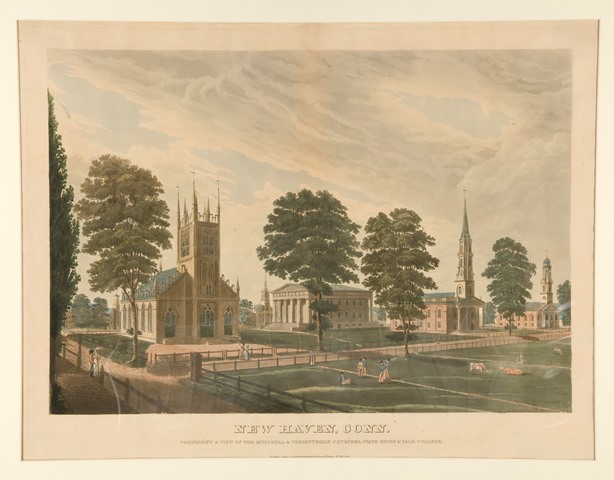By Nancy Finlay
When the 19th century began, solidly built, but simply designed, houses and churches dotted the hills and valleys of Connecticut. The state had few buildings of real architectural significance. The Connecticut River Valley earned a reputation for its distinctive form of ornately decorated doorways, and a few innovative builders experimented with the new Federal Style, but Connecticut had no real architects. Important buildings were either the work of talented amateurs or designed by architects from outside the state.
Hartford’s Old State House, completed in 1796, had its layout designed by Charles Bulfinch of Boston, one of the few professional architects of the 18th century. The First Congregational Church in Hartford came from the vision of Daniel Wadsworth, whose mansion stood nearby. In New Haven, John Trumbull, an important portrait and history painter lacking any formal training in architecture, provided the floor plans for Yale College (later Yale University).
Ithiel Town was one of the first professional architects in Connecticut and one of the first to introduce the architectural styles of Europe to the United States. Born in Thompson, Connecticut, in 1784, he studied architecture with Asher Benjamin in Boston before moving to New Haven and opening his own architectural office.
Ithiel Town in New Haven
Among his earliest works was Center Church, a fine example of the Federal Style, constructed between 1812 and 1815. Center Church is not dissimilar to other churches from the late 18th and early 19th centuries, but Town’s second church on the New Haven Green, begun shortly afterwards, in 1813, is very different, and would not have looked out of place in a small town in England. Built of local traprock from a quarry owned by Eli Whitney, Trinity Church is an early example of the Gothic Revival.

New Haven, Conn. Comprising a View of the Episcopal and Presbyterian Churches, Statehouse and Yale College, hand-colored engraving by Illman and Pilbrow, New York, 1831 – Yale University Art Gallery
Town’s third building on the Green, begun in 1827 and built to house the State Capitol at a time when the legislature met alternately in Hartford and New Haven, took the form of a near-perfect Greek temple. Town employed the style for private homes as well, including the Middletown home of China Trade merchant Samuel Russell, now a part of Wesleyan University. More exotic influences are also to be found in Town’s work. His monument in Groton, commemorating the Revolutionary War Battle of Groton Heights, is a massive obelisk, evocative of Egypt and Renaissance Rome. Thanks to Town, Connecticut’s architecture suddenly became considerably more diverse and interesting.
A scholarly man who amassed an immense library of architectural books, Town was well versed in the history of architecture and aware of the contemporary interest in historic styles in England and on the European continent. His library was an important resource for the many aspiring young architects who came to work in his office, including Alexander Jackson Davis, Henry Austin, and James H. Dakin.

Residence and Library of Ithiel Town, New Haven – Connecticut Historical Society and Connecticut History Illustrated
Town’s Proteges Reshape America’s Architectural Landscape
Davis, who was born in New York City in 1803, worked as an architectural draughtsman before joining Town’s office in 1826. In 1829, the two men became partners. Together with Henry Austin, another former Town assistant, Town and Davis designed the Wadsworth Atheneum in Hartford (1842), America’s first public art museum and a masterpiece of the Gothic Revival.
Town and Davis were especially known for promoting the Classical Revival in buildings such as the Indiana State Capitol (1831–1835), the North Carolina State Capitol (1833–1840), and the United States Customs House in New York City (1833–1842). Following the dissolution of the partnership, Davis enjoyed great success designing country houses, including Lyndhurst, a Gothic Revival mansion overlooking the Hudson River in Tarrytown, New York.
Henry Austin went on to design Gothic Revival buildings for Yale and Wesleyan, a Gothic Revival house for Edmund and Elijah Kellogg in Hartford, and a Greek Revival house for Samuel Simpson in Middletown. Austin also experimented with the Egyptian, Italianate, and Moorish styles.
James H. Dakin played an important role in introducing the Gothic and Classical Revival styles to the Deep South, and was responsible for important buildings in New Orleans and Baton Rouge. Another former Town and Davis apprentice, Richard Carey Long Jr., played a similar role in Baltimore.
Town died in 1844 and is buried in New Haven’s Grove Street Cemetery, with its monumental Egyptian Revival entrance designed by Town’s pupil, Henry Austin. But even after Town’s death, his influence lived on. Architecture had become a respected profession and Americans had access to a wide array of architectural styles. Civic leaders and common citizens now commissioned Greek courthouses, Gothic cottages, or Moorish palaces. In a few short years, Town and his followers helped to transform the built environment of America forever.
Nancy Finlay grew up in Manchester, Connecticut. She has a BA from Smith College and an MFA and PhD from Princeton University. From 1998 to 2015, she was Curator of Graphics at the Connecticut Historical Society.








